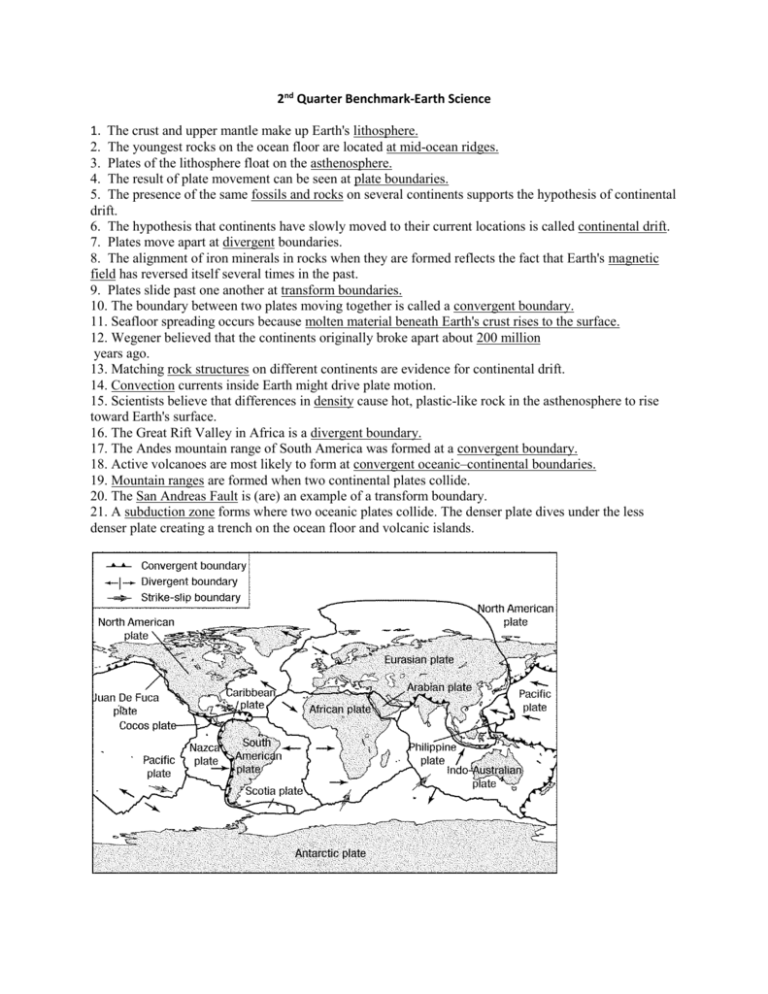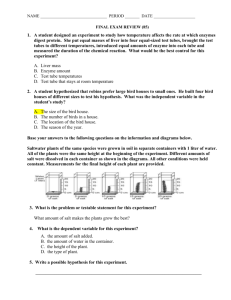2nd Quarter Benchmark-Earth Science 1. The crust and upper
advertisement

2nd Quarter Benchmark-Earth Science 1. The crust and upper mantle make up Earth's lithosphere. 2. The youngest rocks on the ocean floor are located at mid-ocean ridges. 3. Plates of the lithosphere float on the asthenosphere. 4. The result of plate movement can be seen at plate boundaries. 5. The presence of the same fossils and rocks on several continents supports the hypothesis of continental drift. 6. The hypothesis that continents have slowly moved to their current locations is called continental drift. 7. Plates move apart at divergent boundaries. 8. The alignment of iron minerals in rocks when they are formed reflects the fact that Earth's magnetic field has reversed itself several times in the past. 9. Plates slide past one another at transform boundaries. 10. The boundary between two plates moving together is called a convergent boundary. 11. Seafloor spreading occurs because molten material beneath Earth's crust rises to the surface. 12. Wegener believed that the continents originally broke apart about 200 million years ago. 13. Matching rock structures on different continents are evidence for continental drift. 14. Convection currents inside Earth might drive plate motion. 15. Scientists believe that differences in density cause hot, plastic-like rock in the asthenosphere to rise toward Earth's surface. 16. The Great Rift Valley in Africa is a divergent boundary. 17. The Andes mountain range of South America was formed at a convergent boundary. 18. Active volcanoes are most likely to form at convergent oceanic–continental boundaries. 19. Mountain ranges are formed when two continental plates collide. 20. The San Andreas Fault is (are) an example of a transform boundary. 21. A subduction zone forms where two oceanic plates collide. The denser plate dives under the less denser plate creating a trench on the ocean floor and volcanic islands. 22. According to Figure 10-1, what type of plate boundary occurs between the North American Plate and the Eurasian Plate? divergent boundary 23. According to Figure 10-1, what type of plate boundary occurs between the Nazca Plate and the South American Plate? convergent oceanic-continental plate boundary 24. Alfred Wegener believed that the continents were once joined. 25. The name Pangaea comes from two words that mean "all land." 26. The crust and upper mantle make up the lithosphere. 27. Earth's thick, plastic-like layer is the asthenosphere. 28. Plates move together at a(n) convergent boundary. 29. One plate is forced under another in a(n) subduction zone. 30. A(n) mid-ocean ridge is an underwater mountain chain. 31. The main points of evidence for continental drift are fossils, rocks, and climate. 32. When the force on rocks is great enough, they break, producing vibrations called earthquakes. 33. Once the elastic limit of rocks is passed, they break and move along surfaces called faults. (deep cracks or fractures in earth’s crust) 34. A person located twice as far from an epicenter of an earthquake as another person will notice that the time between the arrival of the primary and secondary waves will be larger. 35. Compression is the force that squeezes rocks together. 36. Tension is the force that pulls rocks apart. 37. Shear is the force that causes plates to move sideways past each other. Ex: San Andreas fault 38. Normal faults are caused by tensional forces. 39. Reverse faults are caused by compressional forces. 40. Reverse faults are caused by shear forces. 41. Along a(n) normal fault, rock above the fault surface moves downward in relation to rock below the fault surface. 42. Along a(n) reverse fault, rock above the fault surface moves upward in relation to rock below the fault surface. 43. At a(n) strike-slip fault, rocks on either side of the fault surface move past each other. 44. The most destructive seismic wave are surface waves (because the move the rocks in the crust in numerous directions). 45. The primary waves are the first to reach a seismograph after an earthquake. 46. The point in Earth's interior where the energy release of an earthquake occurs is the focus the point above the focus on the surface is called the epicenter. 47. The magnitude of an earthquake is measured by the Richter scale. 48. Kilauea in Hawaii is the world's most active volcano. 49. One factor that determines whether a volcanic eruption will be quiet or explosive is the amount of water vapor and other gases trapped in the magma. Another factor is the amount of silica which determines the viscosity (resistance to flow). The higher the amount of silica the higher the viscosity. 50. Some volcanoes form islands as lava flows from rifts in the seafloor and builds up high enough to break the ocean's surface. 51. Basaltic magma produces nonexplosive eruptions such as those at Kilauea 52. Silica-rich magma sometimes forms where Earth's plates are coming together and one plate is forced under another, produces explosive eruptions, is thick and gas gets trapped, causing pressure to build up Standard S6E2 a. Demonstrate the phases of the moon by showing the alignment of the earth, moon, and sun. The Moon’s phases occur because from Earth we see only portions of the Moon’s illuminated side (the side receiving the sun’s rays), depending on the moon’s relative position to the earth. The moon never goes away or changes shape-we just see a different fraction of sunlight being reflected from the moon to Earth. We divide the moon's orbital cycle into several segments or phases. After the new moon phase, the moon waxes, or appears to grow larger, and we see more of the moon's face. The lighted area increases over time from right to left (from our perspective on Earth). Remember: “The light starts on the right.” When the sun-earth-moon angle is very small, we see only a thin bright curve, called the waxing crescent. Over the next seven days the angle between the sun, Earth, and the moon grows to 90 degrees. We see the sunlight spread to cover the right half of the moon. This is called the first quarter. The visible part of the moon continues to wax through the gibbous phase over the next seven days until we see the full moon. As the cycle continues, we say the moon is waning, or getting smaller. The amount of lighted area we see decreases, and the darkened area increases from right to left. You can tell if the moon is waxing or waning by whether the right side of the moon is dark or light. (right side light=waxing, left side light=waning). Remember: “The light starts on the right.” This entire process from new moon to new moon takes about 28 days. We always see the same side of the moon because the moon’s rotation and revolution take the same amount of time. b. Explain the alignment of the earth, moon, and sun during solar and lunar eclipses. When an object such as the moon or Earth pass between the Sun and another object, it casts a shadow called an eclipse. Any object that is lit by the Sun will cast a shadow. The darkest portion of this shadow faces directly away from the Sun. In this portion of the shadow, called an umbra, all light is blocked. Around the umbra is an area of a partial shadow where some light is blocked and other light is not blocked. This lighter shadow surrounding the umbra is called the penumbra. When the Moon moves into the earth’s shadow, a lunar eclipse occurs. In other words, the moon is blocked or eclipsed from our view on Earth. A lunar eclipse is the most common and observable type of eclipse and can only happened at night and during the full moon phase when the moon is directly behind the earth compared to the sun. In a lunar eclipse, all or part of the moon is a dark reddish color. The sun, the earth and the moon are aligned in such a straight path, that the only light that reaches the moon is light that has passed through the Earth’s’ atmosphere. When the Moon passes between the sun and the earth, a solar eclipse occurs. The moon’s shadow falls on the Earth, causing a portion of Earth to become dark. Total solar eclipses last for only around seven minutes. Solar eclipses can only occur during the day and during the new moon phase. Because the moon is much smaller than the Earth, the shadow of the Moon does not completely cover the surface of the Earth. The Moon’s orbit is tilted 5 degrees in relation to the plane of Earth’s orbit. Therefore, the Moon’s orbit is usually either above or below the Sun-Earth line making eclipses rare. c. Relate the tilt of the earth to the distribution of sunlight throughout the year and its effect on climate. The Sun is the source of all light and warmth on the Earth; however, not all places on Earth receive the same amount of sunlight. Because the Earth is tilted on its axis, currently at an angle of 23.5° perpendicular to its orbit, different parts of the earth are either tilted toward or away from the sun at various times of the year. When one hemisphere is tilted towards the sun, the other hemisphere is tilted away from the sun. Therefore when it is summer in the Northern Hemisphere, it is winter in the Southern Hemisphere. This tilt of the earth is what causes the seasons. Seasons do not occur because the Earth is closer to the Sun in the summer, and farther from the Sun in the winter. (Due to Earth’s elliptical orbit, the Earth is actually closest to the Sun on January 1st and farthest away from the Sun on July 1st.). When the Northern Hemisphere is tilted toward the sun, sunlight falls directly upon that region. When the Southern Hemisphere is tilted toward the sun, sunlight falls directly upon that region making it summer. Study Guide for Standard 5 Earth Layers- Three main layers; Crust, Mantle, Core Earth Layers broken down- Continental Crust, Oceanic crust, upper mantle, lower mantle, outer core, inner core. Pressure, Density, and Temperature: All increase as we go deeper into the Earth Composition of Earth’s layers: Crust; Oceanic- Basaltic, Continental-Granitic, Mantle Magma (molten/plastic-like rock), Core; outer-molten iron and nickel, inner-solid iron Density: Density increase with depth. Continental plates are less dense than oceanic. Plates- Lithospheric plates (crust & upper mantle) float on the asthenosphere (upper mantle). The movement is caused by the convection currents (movement of fluid caused by differences in heat-heat causes it to rise and fall in an endless cycle) of the mantle. Pangaea- the theory that all continents were once connected. Continental Drift- The hypothesis that the continents drifted apart – Alfred Wegener given credit. Plate Tectonics- The current theory that the Earth is made of plates and the convection currents of the mantle cause them to move. The Oceanic plates also move apart causing sea floor spreading- Sea floor spreading creates the mid ocean ridge (chain of mountains). Evidence for Plate Tectonics: Sea floor spreading, puzzle-like fit of the continents, plant and animal fossils found in all areas of the earth regardless of current climates. For example, a tropical plant fossil found in Antarctica. Also, similar rock/mountain formations in different parts of the Earth, as well as evidence of glacial activity in tropical areas. Plate boundaries: Convergent (coming together), Divergent (spreading apart), Transform (sliding past each other in a shearing motion). Three types of convergent boundaries: Continental-Continental, Continental-Oceanic, OceanicOceanic. Subduction zones: Occur at convergent boundaries, and the denser material will subduct (go under) the other. Oceanic plates subduct under continental plates because of greater density. When two oceanic plates converge, the older, denser plate will subduct. Results of boundary types: Continental-Continental convergent: mountain building, earthquakes; ContinentalOceanic subduction: volcanoes, earthquakes, ridges; Oceanic-Oceanic divergent: sea floor spreading, earthquakes, ridges; Oceanic-Oceanic convergent: mountain building, earthquakes Transform Boundaries: Does not destroy or create crust/rock. Earthquakes occur here. Most famous: San Andreas fault in California. The Ring of Fire: A boundary that is located along the Pacific plate where it meets several other plates and numerous volcanoes and earthquakes develop. Earthquakes: Caused by the pressures within the earth and plate movement. Minerals: Inorganic solids, naturally occurring, with a definite molecular composition and crystal structure. Mineral Characteristics used for Identification: (also includes color, density, smell, taste, & others) Luster: The reflection of light on a mineral. Types are metallic and non-metallic (glass-like, and dull). Streak : The powdered residue of a mineral when dragged across a streak plate. More accurate than color, Cleavage: Minerals will naturally break along flat planes when struck that show crystal structure. ex: cubic, octagonal. Fracture: The result of a mineral with no cleavage points due to stronger molecular bonding therefore it shatters with an irregular surface Hardness: The comparison of one minerals ability to scratch the other based on Moh’s Hardness Scale. Hardness level are between 1 and 10. Diamond is hardest with a rating of 10. Minerals will scratch other minerals with the same rating and lower. Rocks: Different from minerals because rocks may contain organic material. Made of at least one mineral. Rock Cycle: Changes from one rock type to the other happens through melting and cooling of the rock, weathering, erosion then compaction or cementation of sediments, and extreme heat and pressure. Any type of rock can turn into any other type of rock (including the type it started as) and the continuous change is ongoing. Rock Types: Igneous: Intrusive: made from magma, formed inside the Earth, and cools more slowly. Extrusive: Made from lava, formed on or near the Earth’s surface., and cools quicker. Metamorphic Rock: formed by heat and pressure. The type of rock formed depends on the parent (or starting) rock it came from. Sedimentary: Made from sediments. Sediments include: soil, rock fragments from weathering and erosion, may contain organic materials such as shells and other animals and plants. Sedimentary rock is formed through: compaction, cementation, organic, and chemical. Sedimentary rock takes many, many years to form. Sedimentary Terms: Compaction: squeezed together by the pressure of sediments above Cementation: natural gluing of materials when minerals come out of fluid between sediments Organic: made from the remains of once-living plants and animals. Fossils are often found in this type of rock. Chemical: Dissolved minerals come out of solution by evaporation and leave a solid residue to form rock.









